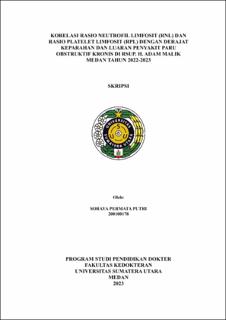Korelasi Rasio Neutrofil Limfosit (RNL) dan Rasio Platelet Limfosit (RPL) dengan Derajat Keparahan dan Luaran Penyakit Paru Obstruktif Kronis di RSUP. H. Adam Malik Medan Tahun 2022-2023

Date
2023Author
Putri, Soraya Permata
Advisor(s)
Nasution, Malayana Rahmita
Metadata
Show full item recordAbstract
Background. COPD is associated with increased systemic inflammation and airway inflammation. The most common cause of COPD is smoking with a prevalence of 30-40%. COPD is associated with increased systemic inflammation and airway inflammation resulting in severe clinical symptoms and decreased lung function. The Neutrophil Lymphocyte Ratio (NLR) and Platelet Lymphocyte Ratio (PLR) are early markers of systemic inflammation and indicators of immune response in the prognostic evaluation of a range of diseases, these conditions can stimulate an increase in RNL and RPL which are used as indicators of inflammation in patients with COPD. Objective. To determine the correlation of Neutrophil Lymphocyte Ratio (NLR) and Platelet Lymphocyte Ratio (PLR) with the severity and outcome of chronic obstructive pulmonary disease at RSUP. H. Adam Malik Medan. Methods. The design of this study was analytic description type with cross-sectional design. Data collection through medical records and using Spearman's rho statistical test. Results. Of the 86 subject data taken, the most age was elderly patients (60.5%), male (84.9%), and there was a history of smoking (81.4%). The most severe degree of COPD was Group E (58.1%), surviving COPD patients (87.2%), and intrapulmonary comorbidities in COPD patients (66.3%). For the Spearman's rho test results, the correlation between NLR and PLR values with severity and outcomes of Chronic Obstructive Pulmonary Disease obtained significance results (p value> 0.05). Conclusion. There is no significant correlation between NLR and PLR with the severity and outcome of Chronic Obstructive Pulmonary Disease.
Collections
- Undergraduate Theses [2259]
